Friday, April 25, 2008
Sunday, October 09, 2005



Washington, DC
Damnit!!! That's really the only word to describe this morning. Rashmi and I were out of town last night and didn't get back to her apartment and my car until this morning. As we got closer to her place from the metro station, I started to notice a few strange things. The street was blocked off, and then there was the police tape across the road, and finally there was the tree laying in the middle of the road. That's when it dawned on me: my car is laying underneath that tree . . . Damnit!!! As you can see from the pictures, a strong wind uprooted a tree and laid on top of my car, crushing the windshield and denting the hood. Good times.
Thursday, September 15, 2005




Washington, DC -- District Patentees Memorial
Caveat: This post is probably interesting only to family members. This is the memorial dedicated to the Federal City's original patentees and is located on the corner of 15th and E Streets about a block away from the White House. Unfortunately, due to some fencing barriers erected for a remodelling project, I was unable to photograph the side of the memorial that displays Zachariah Wade's name, so for now you'll have to use your imaginations. When the fence comes down, I will update the photos.
Aside: for a laugh, check out this Florida fan's take on the real meaning behind the lyrics to Rocky Top.
Monday, August 29, 2005

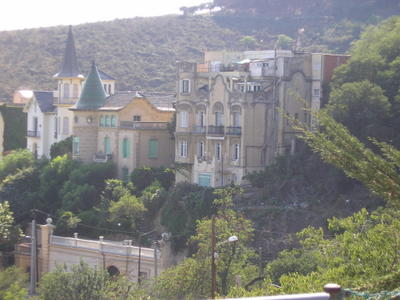


Last Full Day in Barcelona
After two amazing weeks, our vacation has wound to an end and the real world has begun to call -- particularly for Rashmi, who starts her new job in less than a week. We took our last sight-seeing adventure to the top of Tibidabo (which I am told means "I will give it to you" in Catalan and has something to do with the devil tempting Jesus). Tibidabo is a small mountain looking directly down onto Barcelona. From the top, you can see everything: the Pyrenese, the Mediterranean, our hotel, the Sagrada familia, and so on. It is a beautiful view that is only slightly spoiled by the fact that someone thought it would be a good idea to build an amusement park and a basilica within feet of each other on the very top of the mountain. I couldn't think of two things that go better together, could you? I guess Tibidabo's planners made up for their lack of taste with religous zeal.
Pictures: (1) The Basilica atop Tibidabo. (2) A view of the town from the funicular (a slow train that grinds up to the top of the mountain). (3) The funicular station. I wish I could translate the word funicular better, but we don't really have anything like them in the states. (4) A view of the Barcelona . . . and the amusement park.
Rashmi and I are looking forward to getting home and seeing familiy and friends. Hopefully hurricane Katerina won't complicate that process too much.
Sunday, August 28, 2005



St. Sadurni d'Anoia
Not a lot went right yesterday. Rashmi and I took an hour-long train to St. Sadurni d'Anoia, where there are a lot of cava (Spanish champaigne) producers, hoping to tour the bodegas during the afternoon. We started out at the Freixnet winery (see picture), but as we found out at the front gate, they are open every day of the week . . . except for Saturday. Yes, that's right, you can tour the winery right after church service, but not on a Saturday afternoon.
OK, not a problem. Down the road is Codorniu, Catalunya's oldest cava producer, which we had planned to see after Freixnet. We stepped into the restaurant at the train station and gave them a call, which I wouldn't have done normally but given the surprise we encountered at the first bodega I figured it was a good idea. "Hello, um, my girlfriend and I would like to come take a tour in the next half-hour. You are open right now, aren't you?" The receptionist at Codorniu answered, "Oh, senor, I'm really sorry, but we closed 10 minutes ago." It was 2:10 right then; go figure.
Having struck out twice with the cava tours, I thought we might have better luck heading down the road to Vilafranca de Penedes, where we had toured the Torres winery earlier. Yesterday was the start of their weeklong Festa Major, which consists of street fairs, markets, and several displays of Castellers, giant human towers of as many as 30 people. I thought we'd head down there and at least catch some of the Festa before we made our way back to Barcelona. When we arrived there, the town was a ghost town. Trash from the morning's festivities blew through the streets as everyone in the town seemed to be enjoying their siesta. Eventually, we found an open coffee shop, where I stopped to ask when the festa would start back up. I came to find out that the first day of the festa was a very solemn day, centered around the older members of the town reading traditional literature to the crowds before the real festivities began. There would not be any street fairs or castellers until tomorrow, and the closest we came to seeing any was the statue in the square. Strike three!
Rashmi was kind enough not to rub in the fact that all of this aimless wandering had been my idea. I tried to make it up to her by taking her to Petit Paris, a French restaurant in Barcelona, where we were served the best meal we have had in our time here. It was a bit daunting, however, as I ended up eating a carpaccio, the contents of which I am still unaware.
Friday, August 26, 2005



La Rambla, Barcelona
If Times Square in Manhattan is the train wreck that every first-time NYC tourist must catch a glimpse of, La Rambla--a sweeping Bohemian avenue dubbed "the most famous street in Spain"--is Barcelona's version of that crowded, sweaty, over-billed, over-priced thoroughfare. Wade and I briefly strolled down La Rambla the afternoon we arrived in Barcelona. Too cranky and jet-legged that day, we were not exactly impressed and even stayed away from that strip for over a week. But in our earnest effort to at least read the menu of some restaurants recommended in our travel guides (as opposed to aimlessly wandering for about 45 minutes only to eat the same bread and potatoes) we metroed to La Rambla to visit the Cafe de l'Opera. According to an unnamed guidebook Cafe d l'Opera promised to be a "splendid Modernist" venue complete with artists and intellectuals as patrons. After spending the requisite 30 minutes finding the place, Cafe d l'Opera was a dissapointment. Not only did I see fewer artist and intellectual types than in my favorite Nashville coffeehouse, The Frothy Monkey, the tapas bar was paltry, seating was minimal and our only option was a smoky balcony that was too nicotine-laden even by Barcelona standards. In short, it was a tourist trap made worse by the fact that our stomachs were growling and we were stuck in the middle of a sea of equally dismal tourist traps. We finally settled on a cheerful looking tapas bar that filled our bellies but depleted our wallets. My distaste for the La Rambla experience is not a bad thing, I think, because it illustrates how much the off-beat parts of Barcelona get it right. We have had some not so great cheap meals and some really great pricier fare. Just as the seasoned NYC guest quickly learns to stick to the West Village or some other cozier part of town, I think we'll plan on catching meals in our two favorite neighborhoods so far--the Old City (full of windy little Gothic alleys) and L'Eixample (the posh "Park Avenue" of Barcelona with some suprisingly reasonable cafe).
Flamenco--ole!!
After that uninspiring La Rambla dinner, Wade and I followed through with plans to attend a flamenco show. While not quite as ubiquitous as the Hawaiian hula or Persian bellydance, our trip to Barcelona would not be complete without experiencing this age-old custom. Technically, flamenco is not a Catalon tradition but a ritual native to Andalusía in the southern part of the country. Not suprisingly those stoic Catalons--who also eschew Spain's most famous custom, bullfighting--prefer their native dance, the simple sardana. So, we made our way to the quirky little theater Wade learned about from the local Spanish newspaper. The show was absolutely stunning. Lasting no longer than 30 minutes, the intimate room was the perfect setting for a performance that reminded me more of the rhythmic wonder Stomp than any of the preconceptions I had about flamenco. The show centered on cross-percussion, similar to that of African drum beats.
Sitges
Wade and I spent today at again at the beach at Sitges.
--Rashmi
Thursday, August 25, 2005
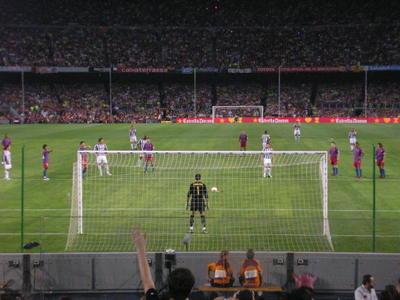



Festa de Juan Gomper
Although Barcelona and Tennessee are thousands of miles apart, the two places share a lot of similarities. People in both places, for example, hold a particular sport more important above all else in their lives -- save perhaps religion. In Tennessee, it's football (particularly of the SEC variety), and in Barcelona it's futbol. And the people here are crazy about their futbo! Every day the newpaper displays pages of articles detailing such minutia as what Ronaldinho (a star player for FC Barcelona) has named his child or where the players met for dinner the night before and every facet of the previous day's game become fodder for op-eds.
Spain, like every other country in Europe, divides it's soccer leagues into tiers. The top tier teams include powerhouses such as Barcelona, Madrid (home to David Beckham and Ronaldo), and Betis. Below the top league is an intermediate-level league and lastly a bottom-level league. Teams that play particularly poorly over the course of a season can be "relegated" to the next league down, and a team that plays very well may be promoted to the next highest tier. It's as if a very good minor league baseball team (e.g., the Nashville Sounds) could be called up to the majors while the Kansas City Royals (current win percentage: .331) could be dropped down to AAA ball. In Spain the top league is called La Liga; in England it's the Premier League; France has the Ligue 1; Italy the Serie A; and Germany the Bundesliga. Every year the top teams from each country's first tier compete against each other in the UEFA Cup. Apart from this competition, however, many leagues coordinate cup matches between their champion and another country's champion. For example, Italy's and Spain's league champions play for the Copa de Juan Gamper.
This is where Rashmi and I found ourselves last night. Barelona, who was last season's La Liga champion played against Italy's Juventus, the Serie A champ from Turin. The experience was all a little bit surreal, as 82,000 screaming, singing, airhorn-blowing fans packed the stadium for the game. It was loud! Even before the announcer called the names of the players, Rashmi and I had to yell to hear each other. And that was before the volleys of indoor fireworks. In the midst of all of the bedlam, the crowd was amazing coordinated, singing songs and shouts throughout the game in perfect unison. Rashmi said she felt like she was at a political rally rather than a sports game. I don't think I've ever seen anything that can compare to last night . . . other than Rocky Top.
Once the game began, it was immediately apparent how skilled these players are. They can dribble with a soccer ball at their feet like Alan Iverson with a basketball. They are unbelievably skilled, precise, and creative, but above all else fast. Ronaldinho, Barcelona's big star from Brazil, was the most fun to watch, and although he didn't play much (the coach took him out of the game before halftime) he was constantly creating opportunities for his teammates with deft passes and drives. Barcelona dominated the first half of play, as the ball remained in their possession in their opponent's half for most of the game, but the scoreboard told a different story. Barca's player missed some easy scoring opportunities and Juventus's keeper made some unbelievable saves. Juventus, on the other hand, was the beneficiary of a fortuitous break. A questionable foul call in the box let Alessandro del Piero notch the game's first score with a penalty kick. The crowd made sure to let the referee know what they thought about him after the call: "Hijo de puta! . . . [five claps] . . . Hijo de puta! . . . [five claps] . . ." and so on. Even the 7-year-old sitting behind us knew the words to the chant.
After half-time, Barcelona turned the tide. Some new substitutes, particularly Leo Messi from Argentina, aggressively pushed the pace of play, leading to two successive Barca goals about ten minutes into the new period. The first goal came from Messi's through-pass behind the defense to Iniesta, who easily pushed the ball past Juventus's poorly positioned keeper. The second goal was an impressive drive through the middle of Juventus's defense. With Barca ahead 2-1 and less than 10 minutes left, the game looked safely won, but just then the referee called another foul on Barca in the box. Although the second foul was clearly warranted, the chant again revived. Juventus's Trezegeut, a forward from France, burried the penalty kick, leaving the game tied as the final whistle blew.
The game was decided by penalty kicks, where unfortunately Barcelona did not succeed. They missed two consecutive kicks as Juventus's players did not miss a one. The Italians scored all of their goal on penalty kicks last night, and one could guess that Barcelona had a sour taste in their mouths after losing a game they had played so well. The crowd poured out of the stadium into the street, but rather than a dejected scene there was a veritable block party everywhere. Finding a cab was certainly an issue, though, as we walked down the Avenguda Diagonal for an hour and a half waiting for a taxi. Thankfully, we found one . . . at 1:30 am. I don't think I'd ever been so glad to see a bed after I got to the hotel.
Wednesday, August 24, 2005
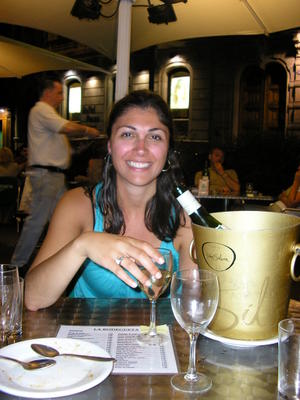
National Art Museum of Catalunya
Rashmi and spent 6 hours yesterday in Barcelona's art museum, which is filled with painting and sculpture from all over Europe from the 11th century A.D. until the present. I wish I could post some pictures from the museum, but unfortunately photography was not allowed.
Nonetheless, the museum was very interesting. One thing that really stuck out to me is that Spanish medieval painting was particularly gruesome. Painting after painting depicted heretics being burned at the stake, or hanged, or stabbed, or drowned, or whatever other violent end you can imagine. The paintings of the Inquisition were particularly nasty. Down the hall, the Christian saints received similar treatments. St. Stephen was a common theme; he pestered the Jews so much about not keeping the law that they stoned him to death (hence the Grateful Dead line: "whereever he goes the people all complain.") St. John the Baptists decapitation, St. Eulalia's buring at the stake, they were all there in gory detail. I wonder if these painters were aware of the irony that they depicted the martyr saints and heretics in the exact same way.
There were more pleasant parts of the museum, though. We saw Dali, Casas, Sissley, and a lot of impressive painters that I'd never heard of.
We'll have more pictures up tomorrow morning. For now, all I've got is a picture of Rashmi's sunglasses tan.
Monday, August 22, 2005
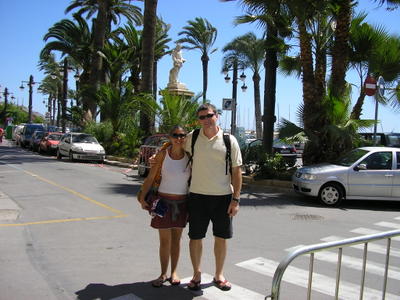
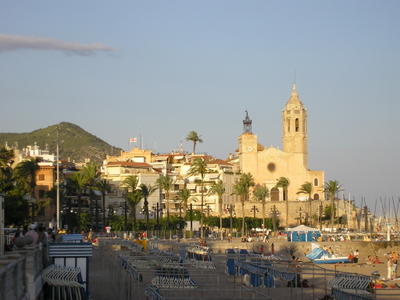

Sitges, Spain
A thirty minute trip south by train took us to the beaches at Sitges (prounounced sit-chez). I should be a little more accurate, though; we spent thirty minutes at the train station trying to figure out which train we should take and another thirty minutes actually travelling in the train. This confusion has been a constant experience with train travel during our trip, as the local train schedule is very complex and poorly explained. I'm convinced that to understand the trains here requires some sort of numerical mysticism akin to cabala. Here's why: There are 7 train lines heading in two directions for a total 14 possible trains. These trains leave every 3 minutes from one of 6 platforms which have no correspondence whatsoever as far as I can tell to the line number, and the trains are marked by their final destination. Thus, navigating by rail would seem fairly simple; if you are lucky enough to be standing on the correct platform and see a train marked with the final destination of the line your stop is on, you are good to go. But, unfortunately, there's a rub! At least three of the train lines have the same final destination, which means that two completely different trains will be marked exactly the same way and come into the same platform. As a result, we once realized four stops too late that we were heading to the airport when we thought we were heading to the mountains. Rashmi and I have abandoned any attempts to devine the mysteries of Spanish rail transit and instead have resigned ourselves to asking a train attendant where we should stand and when we should step on the train -- essentially a leap of faith on our parts.
Sitges is a quaint beach town. I use the word "quaint" in its complimentary sense because the town is a small but bustling and picturesque resort. The streets are narrow alleys much like in Barcelona's Gothic quarter, only filled with rows of boutiques and bistros. Rashmi has already informed me that we'll heading back here soon to go shopping. The beaches are some of the most packed beaches I've ever seen -- and distracting (I won't elaborate this point, but use your imaginations). Rashmi and I spent most of our time on the beach, and as a result I've acquired a bright red tint. Rashmi, on the other hand, is very brown except for the white outline of her sunglasses left on her face.
Shameless plug -- Parents and people who may one day be parents: Some of you may know or remember my friend Allison Schwam, who is currently working for Parenting Magazine. She's asked me to forward on this link, which is a sweepstakes she's working on having something to do with babies and HBO. Just visiting the link will create a "hit" and help her out. You don't have to enter the sweepstakes, but I'm sure it wouldn't hurt.
Note -- Some of the comments that have shown up after some of these post are spam (i.e., people using the comments to try to generate publicity for their websites). I'd avoid clicking on the links in any of the comments unless you know the person who left the comment.
Sunday, August 21, 2005


Top Ten "Off" Things about Barcelona
I've realized after looking over the past few days' posts that I've given Barcelona a very glowing review on the whole. The city deserves this assessment for a lot of reasons, but I don't want to give the impression that everything here is perfect. There are certainly a lot of things that are a little "off" here -- enough so that Rashmi and I put together a top 10 list.
10. The Language Problem -- Barcelonans' Spanish doesn't sound like any other Spanish. People tend to speak at 1,000 mph and swallow their words while their at it. But on top of that most Barcelonans prefer not to speak any Spanish at all, but instead choose Catalan, which is a mix of French and Castillano and sounds vaguely Eastern European. Thus, the language has made navigating the province a real challenge.
9. The Smell -- Barcelona has its own unique odor, which is something of a mix of fish, garbage, and stale water. Mmmmm . . .
8. Grafitti -- Nothing is safe from grafitti here, not even churches.
7. Crazy Nationalism -- As mentioned earlier, there is a strong independence movement in Catalunya. At a time when all of Europe is trying to come together, these nationalists, strangely, are fighting to wrench themselves apart. This sentiment has inspired some highly annoying acts, such as masked protestors stoping a Metro car for an hour.
6. Nonsensical Shirts in English -- English is cool over here. Nearly everyone we've met can speak some English, and often you'll see people wearing shirts written in English. But those shirts don't always make sense, as you can tell from the picture. Fans of the picture will enjoy this website.
5. Men Wearing Capri Pants and Purses -- I could believe the capri pants, but when I saw a man with a purse I was truly, truly stunned. No girlfriend was sighted to help explain this oddity.
4. Catalan Food -- One of my high school history teachers had a sign in his classroom that read something to the effect that in heaven the lawmakers are British and the cooks are French and in hell it's vice versa. Well, those British cooks are easily bested (or is it "worsted?") by their Catalan rivals. A great traditional meal here might consist of salted sardines and pigs feet followed by squid cooked in its own ink. To her credit, Rashmi has been incredibly brave at the table.
3. Height -- Walking about Barcelona, Rashmi and I feel like Jonathan Swift in Lilliputia. That is, people are very small here, both in height and weight. Once in a while, however, you'll catch a family walking by where the men are all over 6'5'' and the women are not much further off, and without exception that family has been German. They must be putting human growth hormone in Germany's water because I've never seen such large people.
2. Smoking -- Spanish people like to smoke . . . everywhere. At lunch you'll see people eating with a cigarrette in one hand and a fork in the other. People smoke on the trains, in stores, in churches, and at the pool. If you like to smoke, this place is your Valhalla.
1. Mullets -- Somewhere along the way, Spaniards never got the message that mullet haircuts haven't been cool since . . . well, I guess they've never been cool. Otherwise stylish looking men sport mullets, women sport mullets, and even young children sport mullets (see photo). It's as if Moses unleashed a plague of mullets on the entire country.




Vilafranca de Penedes
Yesterday, Rashmi and I took a Rodiales train an hour southwest of Barcelona to the Miguel Torres vineyards in Vilafranca de Penedes. The small Catalan town (pop. 30,000) sits at the base of the Penedes Mountains and is one of Spain's largest wine producing regions. One cava (champaigne) producer, Freixnet, even claims to sell more liters annually than all of France combined, but I'm suspicious that this claim needs to be fact checked. The town itself is very Catalan, meaning that the people there do not speak Spanish (Castillano) but rather Catala' and identify more with Paris than they do with Madrid. There's even a peaceful but vibrant Catalan independence movement.
Miguel Torres is a global label, producing a wide variety of wines in Spain, Chile, and recently the Russian River valley in California. Our tour started with a short video intoducing us to the various wine varieties and the Torres family, which looks and acts a lot like the British royal family. From there, we moved on to the most innovative part of our tour: Smell-o-vision. Sitting in a small, dark room, we watched abstract visuals depicting the wine-making process as aerosolizers above our heads exposed us to the smell of vine smoke, grape must, and so forth. It was quite an odd, if not innovative experience.
The vinyard part of the tour, though, was very cool. We essentially followed the winemaking process, starting in the fields, moving on to the "macerators" (I think our guide was having some translation difficulties) and fermentation tanks, and finally to the cellars. The cellar we got to see was more than two square kilometers and contained thousands of barrels. In one corner of the cellar we were able to see the Torres family's private reserve collection, which included a hundred or so bottles from 1906. Our guide assured us, however, that these these bottles are more for show than pleasure, as they had surely turned to vinegar by now (p.s., Mom, they said your '79 bottle of Sangre de Torro has probably met the same fate).
I was a little surprised by the size of the grapes. They are barely larger than a marble (as you may be able to tell from the picture). This is a product of the Spanish wine growing method, which plants the vines four times closer to each other than French or American viticulturalist, thereby causing smaller grapes and yields but higher sugar concentrations.
Palau Nacional de Catalunya
Today has by far been our most laid back day (essentially a pool and laundry day), but we did make it to the national palace to go see the Arqueological Museum. The museum displays arqueological findings (including real skeletons) from the area dating back to the 7th century B.C. up to the 5th century A.D. My takeaway message from the museum is that the Romans were administrative geniuses as they had turned Barcelona into a thriving trade center by the turn of the millenium.
Friday, August 19, 2005

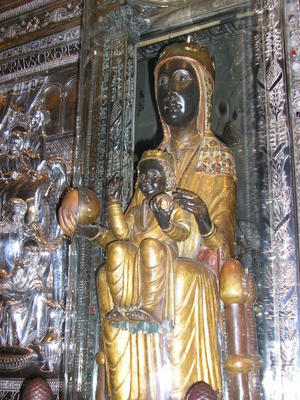


Montserrat
10 words I never thought I'd say: "I spent all day at a monastary and loved it." Montserrat (i.e., "the jagged mountain") is a Catholic monastary high in the mountains north of Barcelona. It's been there in some form since the 9th century A.D. and is so steep that you have to take a cable car to get there. In fact the mountain is so steep and rugged that it's one of Europe's premier mountain climbing spots. All of this, of course, begs the question: how in the world did they built this place? Monserrat was built before anyone had ever heard of Petzl (a mountain climbing company). Assuming that there weren't cable car systems in the middle ages and that pack mules can't walk vertically, I think the monks must have prayed the building materials up the mountain.
The buildings at Montserrat, like all of the churches we have seen so far, are ornately beautiful. Inside the basilica, for example, were endless corridors full of mosaics of the Saints, statues, and crosses. Amongst these relics is the mountain's most famous object: la virgen negra (rumored to have been created Luke and carried by Peter in AD 50). Rashmi and I were able to catch a cadre of monks singing chants in the basilica under this statute. Unfortunately, we were unable to take pictures during the concert, as a signed advised us not to use cameras and also "You are in a Basilica; Dress and Act Appropriately!"
We were also able to walk down a narrow mountain path to the Capilla de Sant Joan, which is builting hanging off of the side of the mountain. As you walk the mile or so to the chapel, statues carved into the side of the mountain depict the stations of the Passion of Christ. The Temptation of Christ was followed by the crowning of thorns and the Crucifiction and so on. This was not an easy walk; the thin air and steep climb made walking feel like sprinting. While Rashmi and I had a hard time with the climb, there were a few ancianos who looked as if they were about to keel over during the hike. Rashmi's perceptive observation: "It's amazing that you can't get a European to work more than 35 hours in a week, but they'll drag themselves up a mountain to go light prayer candles."
We had a few kinks getting back home, but nothing major. We just missed the last cable car down the mountain and had to ride down a track that looked and sounded like the first part of a roller coaster (clack-clack-clack-clack). From there we ended up in a city we'd never heard of, and I had to fumble asking for directions from three 12-year-old girls and their grandmothers. They sent us down some alleys, alongside a highway, and across a bridge until finally -- finally! -- we found the rail station.
Note: At the behest of Mr. LaRoche, I've enabled comments. Let the fun begin.
Thursday, August 18, 2005
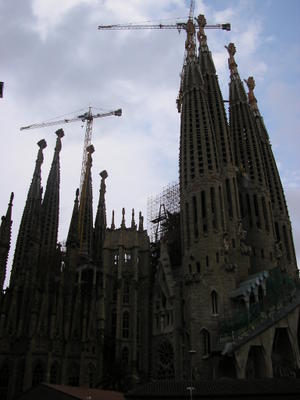


La Sagrada Familia
Typically, the "must see" tourist attractions are recipes for disappointment, as anyone whose been to Graceland can attest. So as Rashmi and I were on our way to see Gaudi's (for whom the word "gaudy" was coined) Sagrada Familia, we weren't expecting much. But were we ever surprised! This church is mind-blowing. The church has been under construction since 1882, and is just over half-way built. Nevertheless, the thing is already unbelievably big and unbelievably complex. Every inch of the building is covered with a mosiac or a sculpture. At first glance it looks as if the builders decided to doodle as they built, but a visit to the museum below the church shows that Gaudi intended every peice of the construction and created intricate models of every part of the building. When I consider all of the purposeful preparation and detail that went into this church, I'm struck by the magnitude of Gaudi's achievement. Designing this building in the time that Gaudi did, would be, in literary terms, like writing the Bible over lunch. Hopefully the church will be finished in my lifetime.
Opera . . . sort of
Rashmi and I capped off the night at L'Espai Baroc, a bar in the Gothic Quarter offering opera by candlelight. It was quite the espectaculo, to borrow the doorman's phrase. As you may be able to tell from the picture, the performance took place in a medieval courtyard filled with some very odd antiques (notice the stuffed aligator in the back of the picture). It was quite the find (thank you, guidebook).
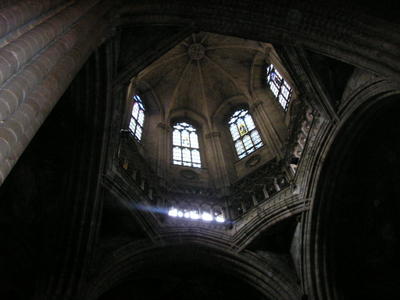
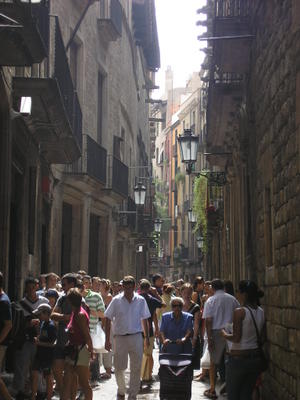


Barcelona, Spain
We did more today than I thought we'd be able to do in a week. We were up by 7:00 and out the door and not back in until 2:30 in the morning. In that span we were able to comb through the Gothic Quarter and see a huge array of museums and shops. There are so many great pictures today that I'm considering putting them all on an FTP server. The neighborhood was built in the middle ages for the Barcelonan aristocracy and is filled with streets (alleys is probably a better word) that are so narrow that the buildings above look like they might touch above (see the picture). We began the morning at the Picasso Museum, which traces his career from his paintings as a child until his death. Just nearby is the Basilica de Santa Maria del Mar, which is an enormous midieval church (second picture). The church was built in the 16th century in less than 55 years, which was apparently extremely rapid for back then. From there, we stopped to get bon-bons at the chocalate museum (spelled here Xocolat) and went to the Parc de la Ciutadella, which houses the zoo, the city's parliament, and very cool lake in which we were able to take a row boat around. The statue at that lake is pictured to the left. From there we back tracked to the Barcelona Cathedral and City History Museum. The cathedral's facade was under construction, but the interior is just as impressive. The first shot in this post is from the front of that church looking up into the front tower. The city museum takes you underneath the city where you are able to walk on catwalks over the Roman ruins of Barcino, the city that existed here from the 1st century BC on. The museum is filled with all sorts of artifacts, which we'd love to show you but we almost got kicked out for taking pictures in there. Altough there's more I could say about yesterday, I'm pressed to get out of the door right now so I'll have to leave it at that.
Tuesday, August 16, 2005
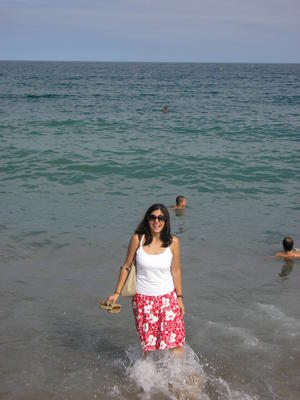

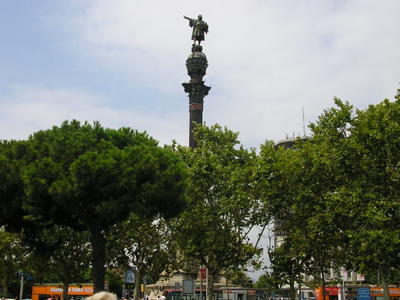
Barcelona, Spain
We arrived safely on the ground at 8:00 am local time and braved a local commuter train and city bus to get to our hotel. Within minutes of being on the ground I realized how much of a challenge the language would be for both of us -- and I even watch TV in Spanish at home. Many conversations so far have broken down into a game of sharades with both participants trading slowly pronounced nouns of the others language. However, I've run into the occasional patient Barcelonan (such as the bank teller I dealt with at El Banco Santander) who is willing to hide his/her smirk as I mangle the language. Rashmi seems to be getting along fine, too.
The flight fast-forwarded through 7 hours of time zones, and after getting only 3 hours of rest during the flight we arrived in this city with one word in our thoughts: sleep. But sleep we could not as we tried to adjust our bodies to the new time zone. Thus, we spent most of the day walking around the south side of the city, seeing La Rambla (a long street that is as much a carnival as it is a shopping district), a city port Port Vell, and finally the beach along the Mediterranean Sea.
Note on the pictures: (1) Rashmi wades in the Mediterranean. (2) The Mercat de Sant Josep off of La Rambla. The seafood in this market was so fresh it was still moving. (3) Christopher Columbus points the way back to where we started our trip
Sunday, August 14, 2005

Murfreesboro, TN
Rashmi and I are packed and ready to leave for Barcelona tomorrow. The picture to the left has nothing to with that, but I thought it was too cool not to post. This is the giant stuffed bear in our hotel in Saint Louis (the Cheshire Inn for you locals). Having a giant bear in the lobby almost makes up for having a television from 1968 in your room . . . almost.
 St. Louis, MO
St. Louis, MOAhhh . . . weddings! Rashmi and I made it up to Saint Louis, MO, home to Washington University, for the Henley-Salomon wedding (both pictured dancing below). Simon's crew came from all over (e.g., Knoxville, Vancouver, South Africa). Martha's contingent hailed from St. Louis, Oklahoma, and Vanderbilt. It was pretty cool to look around the room and see people from so many parts of the globe. It was even cooler to hear their stories, such as the South Africans fending baboons away from their back porch with rocks (this is not an uncommon experience I am told). Rashmi was part of the bridal party, which meant that most of my weekend involved ferrying her from hair appointment, to nail appointment, and so on.
The wedding itself was almost picture perfect. It took place in an old, picturesque Presbyterian church near Wash U, and Simon's minister from Knoxville officiated. I say almost perfect, however, because at the end of the ceremony, right as the preacher pronounced the couple man and wife, there was a tremendous peal of thunder and lightning and all of the power in the building went out. You couldn't have timed it any better. Everyone in the church sat speechless for a few seconds, until the lights began to flicker back on and people remembered to laugh. I guess God must have an impecable sense of humor.
The reception took place at the Bevo Mill, which for those of you not from Saint Louis is literally a giant working windmill in the middle of the city. Very cool, and a good time was had by all -- some better than others as you can tell from the last picture.


